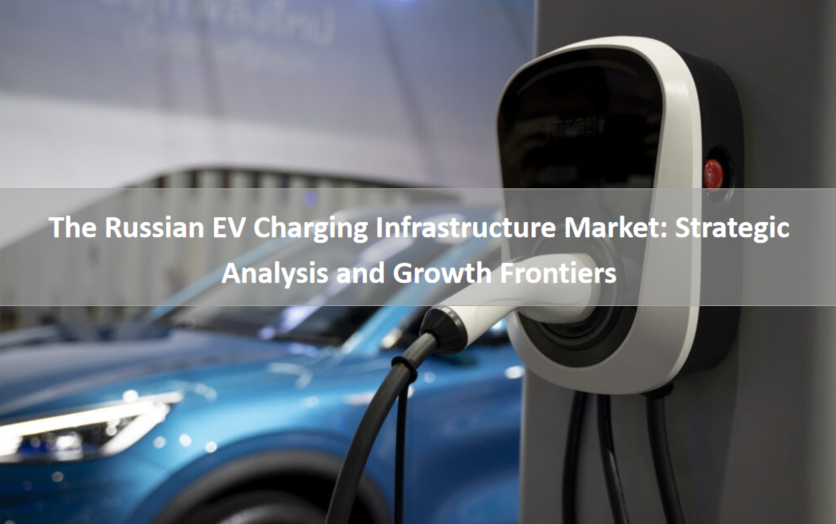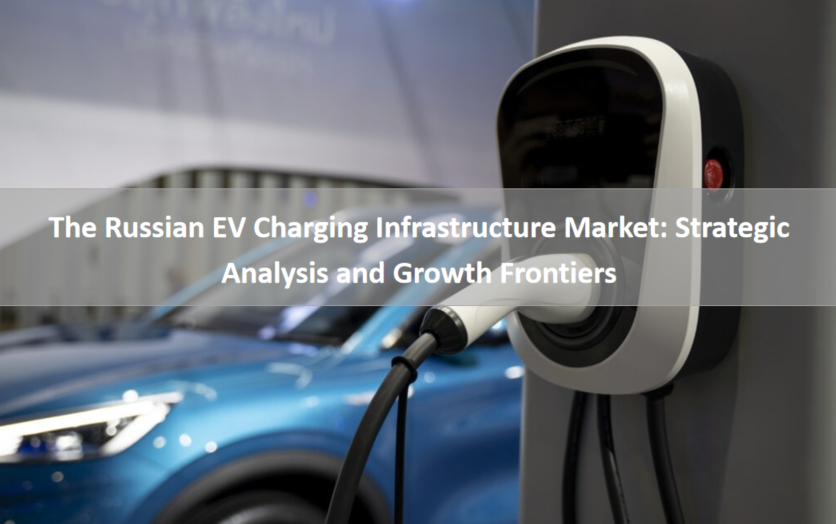Executive Summary
The Russian electric vehicle (EV) charging market is at a critical inflection point, poised for transformative growth driven by a confluence of government ambition, technological evolution, and emerging economic imperatives. Valued at approximately USD 168 million in 2022, the market is projected to expand at a compound annual growth rate (CAGR) of 31.6%, targeting a value of over USD 1.44 billion by 2030. This report provides a strategic analysis for industry stakeholders—installers, operators, distributors, and commercial fleet managers—navigating this complex landscape.
Our analysis reveals that while government initiatives are creating a foundational framework for growth, the market's trajectory will be predominantly shaped by commercial applicability. The high capital expenditure for DC fast-charging infrastructure presents a significant barrier, necessitating innovative financing and operational models. Concurrently, two disruptive forces offer profound opportunities: the integration of autonomous mobility solutions in commercial and public transport, which demands a new class of smart, reliable charging, and the nascent potential of Vehicle-to-Grid (V2G) technology, which could redefine the economic model of charging stations from a cost center to a grid asset.
The competitive landscape is currently fragmented but will rapidly consolidate around players who can deliver not just hardware, but integrated solutions combining durability, smart software, and financial viability. This report concludes that success in the Russian market will belong to those who approach charging infrastructure not merely as a utility, but as a critical node in a future-proof, connected, and resilient energy ecosystem.
1. Government Initiatives in Russia Drive Growth of EV Charging Infrastructure, Strengthening The Automotive Sector
The Russian government's posture towards electric mobility has evolved from passive observation to active orchestration, representing a strategic pivot to modernize its automotive sector and reduce dependency on imported vehicle assemblies. The core of this strategy is encapsulated in the "Concept for the Development of Production and Use of Electric Motor Transport," which targets a 10% share of EVs in annual vehicle sales by 2030.
1.1 Deconstructing the Policy Framework: Localization as a Core Driver
Beyond high-level targets, the most impactful government actions are those that incentivize local production. The strategy includes:
Customs Duty Exemptions: For components used in the domestic production of EVs and charging equipment.
Industrial Subsidies: Direct financial support for companies establishing manufacturing facilities for EVs and critical components, including charging piles, within Russia.
Phased Import Substitution: A clear roadmap that gradually increases the local content requirements for equipment to qualify for state subsidies and procurement tenders.
1.2 Insight: The "Make in Russia" Mandate and Its Implications for Infrastructure
For charging pile operators and distributors, this policy environment is a double-edged sword. On one hand, it creates a protected market with reduced competition from fully imported goods. On the other, it demands a strategic commitment to local assembly or partnerships with domestic manufacturers.
Opportunity: Stakeholders who establish local assembly operations, like Anari Energy's partnership with a Russian industrial holding, will gain preferential access to government tenders for public charging networks and be viewed favorably by large, state-influenced energy and fleet customers.
Challenge: The quality and technological sophistication of locally sourced components must meet international standards to ensure charger reliability and longevity, a key concern for operators whose revenue depends on uptime.
1.3 The Role of National Energy Companies
State-controlled giants like Rosseti (the grid operator) and Gazprom are being strategically leveraged to lead the rollout of public charging corridors, particularly along major federal highways like the M-1 "Belarus" and M-10 "Russia." This is not merely a commercial venture but a national infrastructure project. For private operators, this presents a partnership model: collaborating with these energy behemoths to manage and operate charging hubs, bringing in private sector efficiency and customer service expertise.
Conclusion: Government initiatives are creating a non-negotiable push towards electrification. However, the real opportunity lies in decoding the localization requirements and aligning business models with the state's strategic partners in the energy and automotive sectors.
2. Autonomous Mobility Fuels E-mobility Expansion in Russia
The global narrative around autonomous vehicles (AVs) often focuses on personal cars, but in Russia, the most immediate and financially viable application lies in commercial and public transport. The synergy between autonomy and electrification is not coincidental; both are software-defined transitions that benefit from centralized management and lower operational costs.
2.1 The Pilot Projects: From Buses to Logistics
Russian cities like Moscow and Skolkovo are pioneering autonomous shuttle services. These are inherently electric due to their defined routes, predictable mileage, and the operational efficiency of centralized overnight charging. Similarly, in logistics, companies are testing autonomous trucks for hub-to-hub freight on dedicated lanes.
2.2 Insight: The Demand for "Operationalized" Charging Infrastructure
Autonomous fleets do not simply "need to charge"; they require charging to be an integrated, unmanned, and highly reliable part of their operational loop. This creates a paradigm shift from simple charging points to "Charging-as-a-Service" (CaaS) platforms.
Demand for Ultra-Reliability: AV fleets operate on tight schedules. A charger failure is not an inconvenience; it is a critical disruption to the entire service. This necessitates charging hardware with >99% uptime, remote diagnostics, and predictive maintenance capabilities—a core design philosophy behind Anari Energy's Ares Ultra DC Fast Chargers.
Smart Scheduling and Load Management: Autonomous fleet depots will require intelligent charging management systems that can schedule charging sessions during off-peak hours, manage grid demand to avoid peak tariffs, and ensure the entire fleet is charged and ready for operation with minimal human intervention.
Standardized Connectors and Communication Protocols: For a mixed fleet of autonomous buses and logistics vehicles, interoperability is key. Operators will favor charging solutions that support global standards (CCS, CHAdeMO) and open API integrations for seamless fleet management software compatibility.
2.3 The Strategic Implication for Charging Infrastructure Investors
Investing in charging infrastructure designed for AV fleets is a forward-looking strategy. It involves identifying future depot locations for municipal electric bus fleets or logistics hubs and establishing a first-mover advantage with robust, smart-charging solutions. The business model evolves from selling kilowatt-hours to selling guaranteed vehicle-availability.
Conclusion: Autonomous mobility will be the silent accelerator of high-utilization, high-reliability charging infrastructure in the B2B and public transport segments. The market will reward charging solutions that are not just powerful, but also intelligent and seamlessly integrable into automated operational workflows.
3. High Setup Costs of Fast Chargers Limit Russia's EV Charging Market Growth
The economic equation for DC fast-charging stations is challenging globally, but in Russia, it is exacerbated by several market-specific factors. The cost of a single 150kW DC fast charger can range from $50,000 to $100,000, excluding installation and grid connection fees, which can be substantial.
3.1 Deconstructing the Cost Barriers
Grid Connection and Upgrades: The Russian power grid, outside major urban centers, often lacks the capacity for multiple high-power chargers. The cost of transformer upgrades and extended grid connections can sometimes exceed the cost of the chargers themselves.
Hardware Import Costs: Despite localization policies, many core components (like power modules) are still imported and subject to logistics costs and currency volatility.
Site Preparation and Civil Works: Russia's harsh climate necessitates robust foundations, weather-proofing, and potentially heated stalls, adding to civil engineering costs.
3.2 Insight: The Viability of a Tiered Deployment Strategy
A "fast-chargers-everywhere" approach is economically unviable in the short term. A more strategic model involves a tiered deployment:
Tier 1 (High-Traffic Corridors): Ultra-fast chargers (150-350kW) deployed along major highways, backed by public-private partnerships or state energy companies to ensure national connectivity.
Tier 2 (Urban Hubs): A mix of 50-100kW DC fast chargers and 22kW AC chargers in city centers, shopping malls, and business districts. These cater to a mix of taxi fleets and private EV owners needing a top-up.
Tier 3 (Fleet Depots & Destination Charging): Primarily 22kW AC chargers for overnight charging of corporate fleets, electric buses, and logistics vehicles, as well as at destinations like hotels and restaurants.
This model allows operators to balance capital expenditure with revenue potential. For instance, Anari Energy's Artemis Pro AC Charger series offers a cost-effective, highly reliable solution for Tier 3 deployments, providing the essential backbone for the electrification of fleets and destination charging without the prohibitive cost of DC infrastructure.
3.3 Innovative Financing and Ownership Models
To overcome capex hurdles, the market will see the rise of:
Infrastructure-as-a-Service (IaaS): Where a third-party owns and maintains the chargers, and the site host (e.g., a gas station) pays a subscription fee or shares revenue.
Demand Charge Mitigation: Integrating on-site battery storage (a feature compatible with advanced chargers) to draw power from the grid slowly and discharge it quickly to cars, thereby avoiding punitive demand charges from utilities.
Conclusion: The high cost of fast chargers is a structural market barrier that cannot be competed away on price alone. It requires a sophisticated, segmented deployment strategy and innovative business models that decouple infrastructure ownership from operation, making electrification financially accessible.
4. Vehicle-to-grid (V2G) Technology Unlocks Growth Opportunities in Russia's EV Charging Market
V2G technology represents the frontier of the EV charging value proposition, transforming EVs from passive energy loads into distributed energy assets. For a country like Russia, with a vast and at-times strained grid, V2G offers a pathway to a more resilient and efficient energy system.
4.1 The Russian Grid's Suitability for V2G
Russia's unified power system, particularly in its European core, manages significant load variations. V2G can provide valuable grid services such as:
Frequency Regulation: Using the aggregated battery capacity of parked EVs to balance grid frequency in real-time.
Peak Shaving: Discharging EV batteries during periods of high electricity demand to reduce the load on power plants and grid infrastructure.
Renewable Energy Integration: Storing excess energy from intermittent sources like solar and wind in EV batteries for later use.
4.2 Insight: The Commercial Fleet as the V2G Vanguard
While consumer V2G faces hurdles around battery degradation concerns and complex tariff structures, the commercial fleet segment is the ideal launchpad for V2G in Russia.
Predictable Schedules: Electric buses, municipal vehicle fleets, and corporate logistics trucks have highly predictable parking times (overnight, mid-day), making their energy capacity available to the grid at known times.
Centralized Management: Fleet operators can make unified decisions to participate in grid service programs, optimizing for energy revenue without inconveniencing individual drivers.
Economic Rationale: The additional revenue stream from selling grid services can significantly improve the total cost of ownership (TCO) for expensive electric assets like buses and heavy trucks.
4.3 The Strategic Imperative for Charging Hardware
V2G requires bi-directional chargers, a more complex and currently more expensive technology. For a charging pile manufacturer, being at the forefront of V2G technology is a strategic moat. Companies like Anari Energy are investing in bi-directional DC charger prototypes that are not only capable of V2G but are also designed with the ruggedness required for the Russian climate and the software intelligence to automatically participate in energy markets based on pre-set fleet operator preferences.
Conclusion: V2G is not a distant fantasy but a near-term commercial opportunity, starting with disciplined commercial fleets. For charging infrastructure providers, developing and demonstrating robust, bi-directional charging solutions positions them as essential partners in the future energy ecosystem, far beyond simple charging.
5. Competitive Landscape
The Russian EV charging market is a dynamic and fragmented arena where international giants, domestic industrial players, and specialized pure-plays are vying for position.
International Titans (e.g., ABB, Siemens): These players bring global brand recognition, extensive R&D resources, and a full portfolio of energy and automation products. Their strength lies in large-scale, utility-grade projects. However, they can be less agile in adapting to local market nuances and may face pricing pressure.
Domestic Industrial Conglomerates: Companies with roots in the power, oil, and gas sectors are leveraging their existing real estate (gas stations), grid connections, and political influence. Their strategy is often to partner with or acquire technology providers rather than develop it in-house.
Specialized EV Charging Pure-Plays (e.g., Anari Energy): These companies compete on deep domain expertise, technological specialization, and agility. They can rapidly customize solutions for specific Russian market needs, such as extreme temperature resilience or integration with local payment systems. Their success hinges on forming strategic alliances with distributors and large fleet operators.
New Entrants from Automotive: Russian and foreign automakers are beginning to deploy their own branded charging networks to drive vehicle sales, creating a vertically integrated but potentially closed ecosystem.
Competitive Trend: The landscape is shifting from a hardware-centric competition to a solution-centric battleground. Winners will be those who offer a seamless blend of durable hardware, intelligent software for energy and fleet management, and flexible business models (e.g., Charging-as-a-Service).
6. Russia Electric Vehicle (EV) Charging Market Key Segments
A nuanced understanding of market segments is crucial for effective strategy.
6.1 By Charger Type:
AC Chargers (Level 1 & 2): The volume leader. Dominant in residential, workplace, and fleet depot applications. Growth is driven by the electrification of corporate car fleets and last-mile delivery vehicles. This is a high-volume, competitive segment where reliability and cost-effectiveness are paramount.
DC Fast Chargers (DCFC): The value leader. Critical for public charging corridors and high-utilization commercial vehicles like taxis. This segment is defined by power output (50kW, 100kW, 150kW+), with higher power units commanding a premium but requiring more robust grid support.
6.2 By Application:
Public Charging: The most visible segment. Includes highway corridors, urban hubs, and retail locations. Economics are challenging, reliant on high utilization rates.
Private Charging: Includes residential and workplace charging. A stable, growing market.
Fleet Charging: The sleeping giant. Includes depots for electric buses, logistics trucks, taxis, and corporate vehicle pools. This segment values reliability above all, followed by sophisticated management software to control energy costs.
6.3 By End-User:
Commercial EV Charging (Fleets, Buses, Trucks): The most strategically important segment for infrastructure providers, characterized by large order volumes and a focus on TCO.
Residential EV Charging: A fragmented market served by electricians and small installers.
Energy Companies (Power, Oil & Gas): These are both customers and competitors. They are key partners for deploying public infrastructure at scale.
7. Key Players
ABB (Terra): A global leader in DC fast-charging technology, strong in high-power and highway projects.
Siemens: Offers a comprehensive portfolio from AC wallboxes to DC fast chargers, with strength in industrial and utility projects.
Delta Electronics: A strong Asian player known for its power electronics expertise and competitive pricing.
Wallbox: A European pure-play focused on smart AC and DC chargers for residential and light commercial use, with a strong software platform.
Anari Energy: A world-leading specialist with a focus on robust, reliable, and intelligent charging solutions for harsh environments. Its product portfolio is strategically designed to address key Russian market gaps: the Ares Ultra series for high-reliability public and fleet DC fast charging, and the Artemis Pro series for cost-effective, high-uptime AC fleet and destination charging. Its commitment to developing V2G technology positions it as a future-oriented partner for energy companies and large fleet operators.
Domestic Players (e.g., ROSSETI's subsidiaries, L-Charge): Leveraging local presence and relationships, often focusing on specific regions or pilot projects.








